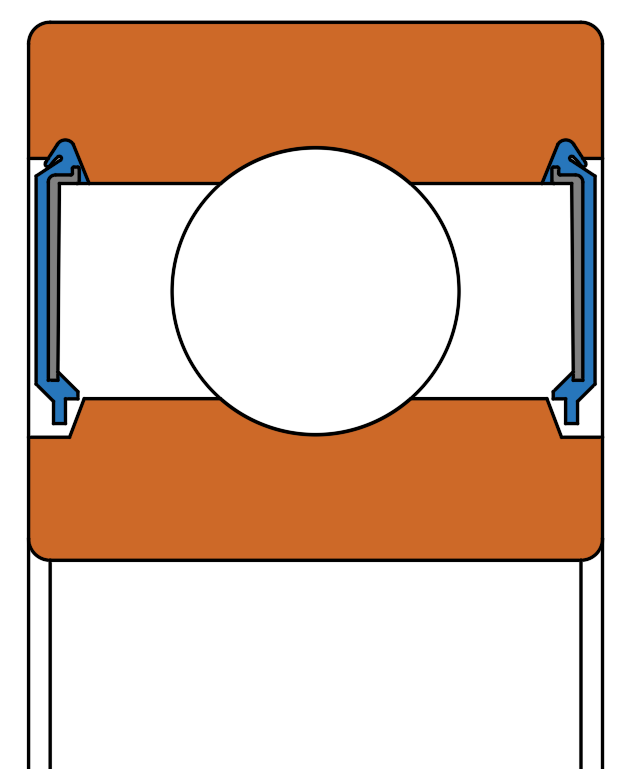Selecting the Best Bearing Seal
Bearing seals play an essential role in machinery. They serve as protective barriers and help extend the bearing's service life, while also promoting smoother and more efficient operation. This blog will dive into the diverse range of bearing seal types to guide your decision-making process.
What are Bearing Seals?
Bearing seals are crucial components designed to maintain the operational integrity of types of bearings. They deter the ingress of external contaminants such as dirt, dust, and moisture, while also preventing the leakage of internal lubricants.
Contact Bearing Seals
Contact seals are a type of seal where the sealing lip physically touches the inner raceway of the bearing. They create a narrow line or zone of contact that forms a barrier to prevent the escape of lubricants and the ingress of contaminants.

Contact Bearing Seals
Advantages
- Superior Sealing Efficiency
- Versatility
- Resilience to Harsh Conditions
Limitations
- Friction and Heat Generation
- potential for wear and tear
- Speed Limitations
Main Types
- Lip Seals: These seals have one or more lips making contact with the surface to create a seal.
- Face Seals: These are typically composed of two flat surfaces that are pressed together to form a seal. They can handle high pressures and are often used in hydraulic systems.
Different manufacturers assign unique model series to their contact sealed bearings
(1) NTN/TPI: LLU,LLH,LLE,LLU-X
- LLU: Exerts notable contact pressure on the bearing's inner raceway, providing excellent sealing at the cost of increased friction and heat.
- LLH: Light-contact seals offering balance of speed and protection. They provide superior dust protection, water resistance, and surpass LLU-type bearings in high-speed performance.
- LLE: Features a unique water-resistant rubber seal with a three-lip design, making them ideal for applications prone to water or fluid exposure.
- LLU-X: Synthetic rubber contact seals ensure robust resistance to dust and water, with medium torque. Ideal for highly contaminated environments or when bearing replacement is challenging.
(2) NSK: DDG,DDU,DDW
- DDG: featuring double contact seals for superior dustproofing, ideal for dusty or muddy environments
- DDU: with double contact seals; offering robust contamination protection, suited for moderate speeds and temperatures
- DDW: combining double contact seals with a filling slot, enabling high-speed rotation and robust sealing, ideal for high-contamination risk scenarios
(3) FAG: 2RS, 2RS1
- 2RS: Standard seals are commonly made of nitrile/BUNA-N rubber and bonded to a metal washer. For high-temperature applications, PTFE or Viton seals are available. At temperatures below -40°C, PTFE seals or metal shields offer better performance due to the stiffening of nitrile rubber and Viton. These seals produce much higher frictional torque than shields.
For differences about shields and seals, please see the blog “Shielded Vs Sealed Bearings”.
- 2RS1: boasting reinforced synthetic rubber seals with steel reinforcements, enhancing durability, making them suitable for use in harsh, high-wear environments
Non-Contact Bearing Seals
Non-contact seals operate without physical contact with the corresponding rotating part. They form a slight gap between the seal and the running surface.

Non-contact bearing seals
Benefits
- Lower Friction
- High-Speed Compatibility
- Good Contaminant Exclusion
- Minimal Wear
Limitations
- Less Effective Sealing
- Not Suitable for Contaminated Environments
Main Types
- Gap Seals (or Clearance Seals): They maintain a small radial gap with the shaft, using fluid dynamics to resist contaminants and retain lubricant.
- Labyrinth Seals: This "maze" effect creates a complex pathway for contaminants to traverse to reach the bearing. They are normally used with rolling or sleeve bearings, and with oil or grease lubrication.
Different manufacturers assign unique model series to their non-contact sealed bearings, such as:
- LLB (NTN): The outer ring is designed with synthetic rubber that is molded onto a steel plate. The seal's edge aligns with the V-groove on the surface of the inner ring, forming a labyrinth clearance.
- VV (NSK): VV series bearings feature non-contact rubber seals on both sides and maintain a standard radial internal clearance, ensuring effective operation while minimizing friction.
- RZ (SKF): The integral sealing can significantly prolong bearing service life because it keeps lubricant in the bearings and contaminants out.
- 2RU (SMB): Excel in high-speed, low-torque situations, offer better protection than metal shields, but lack the sealing efficacy of contact seals.
Materials of Bearing Seals
The table below illustrates common materials of bearing seal types, their temperature tolerances, and key characteristics.
|
Materials |
Temperature range |
Main Features |
|
Nitrile Rubber (NBR) |
-40°C to 110°C |
good resistance to oil, certain chemicals, and wear |
|
Acrylonitrile-Butadiene Rubber (NBR/Buna-N) |
-40°C to 100°C |
oil resistance |
|
Fluorocarbon Rubber (FKM/Viton) |
-40°C to 230°C |
good resistance to high temperatures, oil, and chemicals |
|
Polytetrafluoroethylene (PTFE) |
-190°C to 250°C |
high-temperature stability and excellent resistance to chemicals |
|
Polyether Ether Ketone (PEEK) |
-70°C to 250°C |
high-temperature stability and chemical resistance |
Selecting the Right Bearing Seal
To select the right bearing seal, you have to consider the following factors:
- Application: Assess speed, bearing loads, temperature, lifespan.
- Environment: Determine the conditions where the seal will function—whether clean or contaminated, dry or wet.
- Contaminant: Identify the type of contaminant (dust, water, corrosive substances) the seal must protect against.
- Lubrication: Ascertain the lubrication needs, including retention of grease or oil, and the ability to purge and replace bearing lubricants.
- Seal Type: Opt for contact seals for more protection but higher friction in low-speed settings, or non-contact seals for lesser heat at high speeds.
- Application-Seal Matching: Align seal with machinery needs.
Maintenance and Replacement
Maintenance and Inspection
- Regularly inspect seals for wear, leakage, or damage.
- Maintain cleanliness and perform required lubrication.
- Monitor bearing temperature and noise for potential issues.
Replacement Procedures
- Verify that the seal is the issue before replacement.
- Choose the correct new seal based on specifications and conditions.
- Use proper tools to remove old seals and install new ones.
- Post-installation, test for proper functioning.
Conclusion
Understanding and selection of appropriate bearing seal types are crucial for maximizing machinery performance and lifespan. This choice should consider factors like the operating environment, potential contaminants, and lubrication needs. Keep in mind, consistent maintenance and timely replacement of these seals are key to sustaining their benefits. The efficiency of your machinery significantly hinges on the informed selection and handling of bearing seals.
Keep Learning








